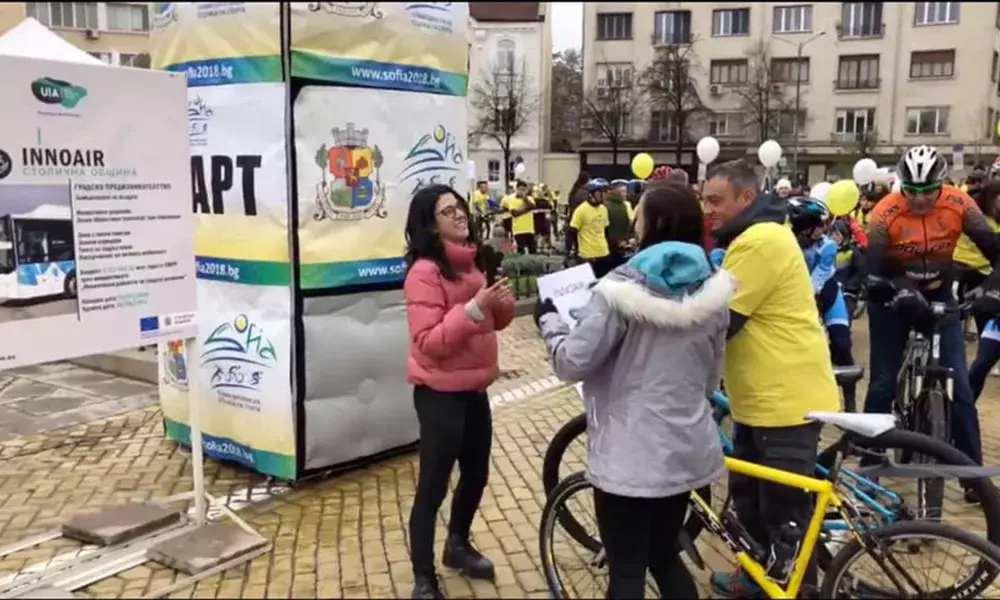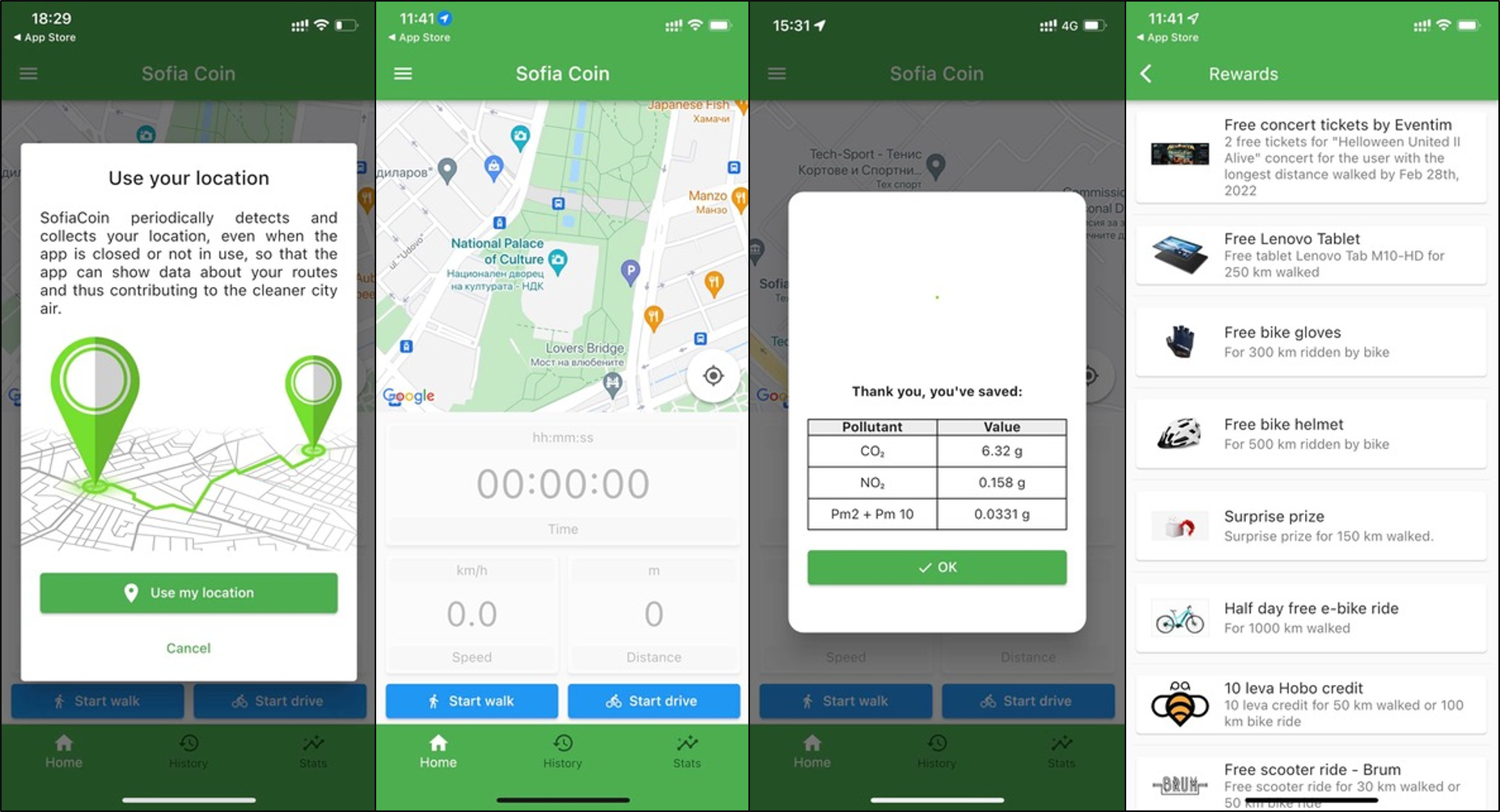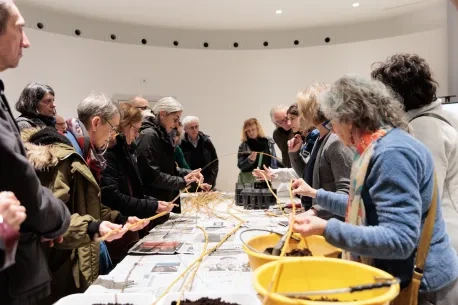
By the project “Innovative demand responsive green public transportation for cleaner air in urban environment“ (INNOAIR), funded under Call 5 of the Urban Innovative Actions (UIA) for the topic air quality, the Municipality of the Bulgarian capital Sofia is taking actions against noxious emissions from road transport. The topic is highly relevant in view of to the extreme motorization rate of the city: While the European average is 45 registered cars per 100 inhabitants, in Sofia it is 70, causing heavy congestion, affecting air quality, livability and traffic efficiency.
At the core of the INNOAIR project activities are four pilot tests of innovative services, namely green corridors, congestion charge, low emission zones, and green on-demand public transport. The latter shall improve the convenience and attractiveness of public transport by a first of its kind realization of innovations to better connect new suburban residential areas of Sofia with the end stations of the urban metro system through the deployment of a fleet of five electric mini buses that will not only drive emission-free, but also offer on demand, shared mobility services. The management of the fleet and the services will be based on a sophisticated software platform that responds to the usage requests of citizens with optimal routes determined with the help of artificial intelligence (AI), machine learning and big-data analytics. Furthermore, the project is motivating citizens to change their mobility behavior by its other measures, i.e. the congestion charging, the low emission urban zones preventing cars to enter the city center at high pollution, and the green corridors stimulating the cultural shift from individual to public transport and soft mobility modes.
The INNOAIR project, which is coordinated by Sofia Municipality has a budget of 4.6 million Euros, co-funded at 80% by the UIA. It has been planned for a duration of three years from July 2020 to June 2023. Partners include the Sofia Development Association (SDA), Sofia University, Plovdiv University, Sofia Urban Mobility Center, National Association of Municipalities, Modeshift Europe, and National Institute for Meteorology.
In the months before the period covered here, the INNOAIR project had already concluded its initialization phase with the creation of the fundamental project structures for coordination, data, investments and quality management. Also, mechanisms for stakeholder involvement, partner engagement and citizens’ participation had been put into place and the tools for communication like, e.g., the social media channel on Facebook had been established. Moreover, first implementation steps towards greener and demand-responsive public transportation had been taken in Sofia.
From April 2021 on, the particular focus of the INNOVAIR project activities has been to gather an understanding of citizens’ expectations from the shared e-bus service and the related public transport policies, to plan the e-bus routes in new residential areas of Sofia and to create the AI-and-big-data-enabled platform and dashboard for the on-demand operations jointly with the academic partners. Moreover, actions to engage citizens in debates and ideation about how to make mobility in Sofia smarter and greener took place, and significant effort was spent on promoting its measures, e.g. in the context of the “Bike Parade 2021 - Sofia cycles and runs for cleaner air“ (see figure 1).

Presentation of the INNOAIR project at the Bike Parade 2021 in Sofia
The coordinators of the INNOAIR project also were invited to present their approach at the European Parliament's Special Committee on Artificial Intelligence in a Digital Age (AIDA) that organized a workshop on Artificial Intelligence and Public Administration in May 2021. The workshop addressed the use and impact of AI in public services in the EU, and highlighted a number of AI use cases in public administration, e.g. for improving processes and document handling, fighting crime, and the management of urban mobility. In their presentation, the representatives of INNOAIR pointed to a number specific opportunities and challenges for the deployment of AI in the control of public transportation fleets: It would allow to offer pro-active transport services in underserved areas by flexibly adapting bus routes to identified demand patterns, and thereby raise the quality and efficiency of public transport. However, it would require to use and analyse data from multiple sources requiring capacity building and regulation.
Moreover, during the European Green week in June 2021, the Municipality of Sofia held a virtual three-day hackathon where it challenged teams from high schools, universities and startup companies to ideate and prototype ways to make Sofia’s urban mobility smarter and greener (see figure 2). The focus areas of the hackathon covered integration and intermodality, incentives for “eco” citizens and user experience and feedback. Examples of the solutions that the 24 teams presented were, e.g., a camera-based system to make public transport responsive to demand by determining the occupancy level of public buses, a voice-assisted mobile app that improves the accessibility of public transport for vision impaired people by facilitating to communication with drivers, and a system of air quality sensors and purifiers reducing pollutants locally at bus stops. The solution that won the hackathon was a mapping tool called sofenhagen that helps cyclists to find the best routes in Sofia, to rate them and to share their experiences (www.sofenhagen.com).

Jury of the INNOAIR hackathon challenging high school and university teams to ideate and prototype ways to make Sofia’s urban mobility smarter and greener
The most recent output of the INNOAIR project is Sofia Coin, a mobile app launched in December 2021 that encourages citizens to contribute to cleaner air by walking, cycling or using a scooter (see figure 3). The app measures the distance travelled and the harmful emissions saved per trip, and rewards individuals for their sustainable mobility habits with e.g. free tickets for public transport, electric scooters or public bike service, or entry to the Sofia Zoo. Moreover, there are premium rewards for those that score highest once in four months. At the same time, the data collected by the Sofia Coin app is used to improve the conditions for more active and zero emission travel modes in Sofia in a comprehensive way: highly frequented walking and cycling routes determined by the app are included in Sofia Municipality’s investment programme to maintain and improve their quality.

Dashboard of the Sofia Coin mobile app developed by the INNOAIR project to incentivise the shift to active and soft mobility modes such as walking and cycling
With its highly effective first achievements and the ambitious plans for the coming months, the INNOAIR project is playing a ground-braking role for more sustainable and more intelligent urban transport policies.
At the local level, INNOAIR helps to create citizen’s buy-in for regulative measures such as the low-emission zones and congestion charges that the City Council of Sofia is about to establish end of March 2022 (see figure 4). The need for low-emission zones in Sofia is backed by a recent study of the Clean Air Fund in partnership with ICCT, FIA Foundation, TRUE, the Swedish-Bulgarian Chamber of Commerce and Sofia Green published in December 2021. The study found that Euro 4 standard diesel and older cars disproportionately contribute to nitrogen oxide (NOx) and fine particulate (PM) emissions in the city, while a more than 90% reduction in average car NOx emissions could be achieved over the next ten years, if low emission zones were introduced.

Plans for low emission zones and congestion charges in Sofia providing the policy framework of the INNOAIR project
On a wider, European scale, INNOAIR can be considered a frontrunner in implementing the objectives of the “New Urban Mobility Framework” that the European Commission published in December 2021 as part of its Transport Package. The framework is addressing the primary challenges of urban mobility in terms of congestion, emissions, and noise, and gives guidance on how cities can cut emissions and improve mobility by optimizing and promoting public transport, walking and cycling. Priority shall be given to zero-emission solutions for urban fleets, including ride-hailing services and new digital solutions and service. As these concepts are implemented by INNOAIR already now, the project may be referred to as a best practice example when the European Commission will propose a recommendation to EU Member States for the development of national plans to assist cities in developing their mobility plans in 2022.
The development of the INNOAIR project activities has regularly been analysed regarding the seven implementation challenges, and some lessons learned have been identified.
2.1. Leadership
While the INNOAIR project is coordinated Sofia Municipality, represented by the Mayor, the day-to-day leadership role is pursued by Ivan Nikolov, the city’s Director for Transport, with support by Sevdalina Voynova, Programme Director at the Sofia Development Association. Due to previous experiences with managing ambitious international collaborative projects the team has not faced any relevant leadership issues during the period covered by this journal. In contrary, given the high relevance of the INNOAIR project in view of Sofia’s future mobility policies, the coordinators continuously received the necessary support from the side of the city government.
2.2. Public Procurement
With a planned investment of 1.5 Million Euro, the most significant public procurement of the INNOAIR project relates to the purchase of five electric mini buses which are to be deployed for the service concept of the INNOAIR project. As the procurement had been planned to be fully concluded by June 2022, it turned out in Fall 2021 that drafting the technical specifications and launching the call for tenders would be urgent. The reason for this mainly were the particular requirements of the special on-demand operating model: The aim is to have an electric range of 250 km, allowing numerous of the typically 4 to 5 km trips connecting places in a new residential area with the metro end station every day. It was also understood that a late call for tender might give rise to delays in the project implementation, since the COVID-19 pandemic was causing interruptions and delays in supply chains, leading to limitations in the availability of key technologies worldwide. This would be particularly the case for electric and electronic subsystems for automobile technologies, where months of delays in end product delivery may occur. In light of these risks, the project coordinators have strengthened their efforts to push up the launch of the call for tenders and finally were able to release it before the end of 2021.
2.3. Participation
While the INNOAIR project consortium provided multiple opportunities for citizens to co-create the green and demand-responsive public transport services for Sofia, and summarised the findings in a register of “131 Ideas for Empowerment in the Transition to Sustainable Mobility”, it also recognized that strong differences in the public opinion exist on the choice of service areas, the determination of appropriate tariffs and the targeted user groups. Based on the discussions in citizen focus groups, it was concluded that the on demand bus service should be operating on fixed routes with defined stops while being flexible in timing. It was also found that a tariff model covering the on-demand trips by a regular system wide ticket valid for with ½ or 1 hour would best fit user expectations.
2.4. Cross-Department Working
The implementation of the INNOAIR project requires a close and highly aligned collaboration of the different agencies, institutes and universities involved in the project consortium. This was for example the case for the Sofia Coin mobile app where the Sofia Development Agency was in charge of the development process, while the Sofia Mobility Urban Mobility Center was responsible for the implementation and the private company Modeshift Europe was handling the users’ mobility data. As a consequence, joint processes for data sharing and storage needed to be defined, particularly in view of compliance with the EU General Data Protection Regulation (GDPR) for person-related data.
2.5. Monitoring
The progress of the INNOAIR project is determined regarding its effect on air quality by measuring changes in the concentration of black carbon, a major component of particulate matter that is considered the most harmful form of air pollution. In the period covered by this report, the National Institute for Meteorology has set up the Bulgarian Chemical Weather Forecast System such that background concentrations of key pollutants can be reported. In the next step, local dispersion models are needed to determine the background concentrations of pollutants in view of the spatial and temporal characteristics of the districts where INNOAIR project measures will be implemented. This shall serve as the baseline for analysing the achieved effects of cultural shifts in mobility behavior and green on-demand transportation on the air quality in Sofia.
2.6. Communication
Creating broad awareness for sustainable and smart mobility in Sofia is one of the most important objectives of the communication activities of the INNOAIR project. The coordinators admit that this topic is causing strong feelings in the public that are occasionally also reflected in the media. Particularly prior to the national Bulgarian elections in April 2021 and to their repetitions in June and November, road traffic measures like congestion charging and low-emission zones promoted by INNOAIR were heavily challenged by some politicians. The INNOAIR project took a number of actions to get buy-in from citizens e.g. through participation in the "Bike Parade 2021 – Sofia cycles and runs for cleaner air", where the project awarded free tickets for the opera.
2.7. Scaling-Up
Measures for scaling-up of the project outcomes are foreseen in the INNOAIR concept, e.g. by the involvement of National Association of Municipalities in the Republic of Bulgaria in the consortium. A prominent first example of the scaling-up activities is related to low-emission zones for which INNOAIR is developing white paper. The first low-emission zones banning the entry of cars without a European standard, those with Euro 1 and some cars with Euro 2 are under preparation for Sofia. Their implementation shall take effect from Winter 2022/23 on, and other Bulgarian cities are planning to follow the examples of Sofia within the next few years: Plovdiv intends to ban all cars except those meeting the highest Euro standards from its central district, and Burgas is planning two low-emission zones, one for the city centre from 2024 on, and one for a wider area from 2027.
In summary of the April to December 2021 period, the INNOAIR project has taken a number of successful actions in implementing highly-interlinked innovative services for the improvement of air quality in Sofia, i.e. green corridors, congestion charge, low emission zones and, particularly the highly innovative green on-demand public transport: Potential routes were identified and the AI-and-big-data enabled software platform for its management was created. Moreover, the launch of the Sofia Coin app, that is incentivizing citizens for using green and active mobility modes, and the creation of the low emission zones in the city of Sofia are significant achievements of the project.
Some of the typical challenges of implementing UIA projects obviously have not, or not yet, significantly affected INNOAIR, e.g. leadership, and monitoring, where mostly preparatory work has been done so far. Still, a number of specific lessons were learned: The public procurement of the electric mini buses was likely to take longer than expected due to the sophisticated requirements of the on-demand service and the COVID-19 induced supply chain disruptions. Cross-department working was challenged by the difficulties in agreeing in common standards for data sharing and storage for the Sofia Coin app. Moreover, some of the communication actions were met with opposition by the public, particularly the media, in the times leading to several national elections. This challenged the INNOAIR project with taking careful measures for promotion and gaining public acceptance for months. At the same time, some of the typical challenges of UIA projects have been solved in an ideal way, e.g. the scaling-up of the concept of low emission zones with other Bulgarian cities, and the participation of citizens in the co-creation of the service and the definition of routes and tariff structures of the on-demand bus services.
Overall, the INNOAIR project is also fully in line with the objectives of the “New Urban Mobility Framework” that the European Commission published just recently. It can be considered and should be promoted as a best practice example for it.
About this resource
The Urban Innovative Actions (UIA) is a European Union initiative that provided funding to urban areas across Europe to test new and unproven solutions to urban challenges. The initiative had a total ERDF budget of €372 million for 2014-2020.
Similar content




